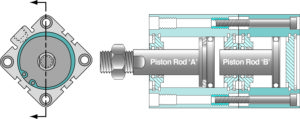
Bored body design.
The “less is more” trend seems to be prevalent in the pneumatic actuator market, as real estate on OEM equipment is at a premium. Compact air cylinders go back to the late 1950s, and satisfy the need for short stroke, low profile, compact actuators that have to fit in very tight spaces. In fact, this cylinder type provides the longest stroke possible in the smallest overall envelope size.
Today, compact cylinders using compressed air are most often the primary solution when space is limited and mechanical actuation is desired. A typical compact air cylinder is between the bore size range of ½ to 4 in. (12 to 100 mm) with standard strokes ranging from 1/16 to 4 in. (1.5 to 100 mm). With the typical maximum standard stroke of 4-in. (100 mm), these cylinders are also frequently referenced as short stroke cylinders.
The original pancake cylinder is a bored body design as shown in the cutaway view in Figure 1. In addition to the bored body design, compact cylinders are now offered in a conventional tie-rod/spacer configuration in both a round and square design, Figure 2, as well as extruded body designs, Figure 3.
Compact air cylinders have a piston rod configuration (as opposed to a rodless cylinder). Piston rod cylinders function in two ways: double-acting and single-acting. Double-acting cylinders (of which Figure 1 is an example) use compressed air to power both the extend and the retract stroke (moving the rod back and forth). This arrangement makes double-acting cylinders ideal for pushing and pulling loads. Here are some common double-acting, compact air cylinder application functions:
• Assembling
• Bending
• Clamping
• Feeding
• Forming
• Lifting
• Lowering
• Positioning
• Pressing
• Processing
• Punching
• Shaking
• Sorting

Round and square head designs.
Single-acting cylinders have compressed air supplied to only one side of the piston; the other side vents to atmosphere. Depending on whether air is routed to the cap or rod end determines whether the rod extends or retracts. The most common type is pressure-extended with an internal spring returning the piston to its original position when air exhausts. This is typically called spring return.
Spring extend is when air pressure retracts the rod and the spring force causes the rod to extend when pressure is removed. This makes single-acting cylinders suitable for when a force is needed in one direction only and where the return stroke is unimpeded and unloaded. These are also popular in areas where, for safety reasons, a defined position must be taken in the event of a power failure. Typical single-acting, compact air cylinder application functions include:
• actuating of flaps and levers
• clamping
• ejection
A single-rod configuration is far and away the most common throughout the entire air cylinder industry. However, a double-rod cylinder design is quite useful in many applications.
Double rod cylinders are used:
• when equal displacement is needed on both sides of the piston
• when the cylinder is required to perform work on both sides
• when it is mechanically advantageous to couple a load to each end, or
• when the extra end can be used to mount cams for operating limit switches.
Multiple piston options

Cutaway diagram of a four-piston cylinder.
Multiple pistons are used to increase thrust force of the cylinder. Multi-Power air cylinders from Fabco-Air provide the same output force as much larger bore, single piston cylinders. Higher forces can be achieved in tight spaces versus larger bore cylinders, which require a larger footprint and center-to-center space when more than one cylinder is required.
This technology has been incorporated into the compact cylinder segment as well. Figure 4 shows a 4-stage force-multiplying compact cylinder. Figure 5 shows its extend function in a cross-sectioned view.
If the application requires a compact style air cylinder as well as intermediate load position, three or more rod positions can be achieved via a single cylinder. The most popular is the 3-position configuration.
Figure 6 shows a cross-sectioned view of an extruded body, 3-position cylinder in which the piston rods are shown partially extended for illustration purposes. The two cylinder bodies are coupled using two socket head cap screws. Piston rod ‘B’ extends through the cap end of the front cylinder and can push Piston ‘A’ as it extends. To set Position #1, imagine that both pistons are retracted; in Position #2 Rod ‘B’ extends moving Rod ‘A’ partially forward; Position #3 is reached when Rod ‘A’ is fully extended. You can see that Rod ‘A’ must be longer than ‘B’ in order to get three discrete positions with your cylinder.
Applications

Cutaway diagram of a three-position cylinder.
Compact air cylinders are selected by their ability to perform a specific function. These functions are boundless. Here is a sample of some common applications and industries that typically employ compact air cylinders:
• aftermarket automotive
• animatronics
• automotive assembly
• conveyor systems
• custom-built machinery and equipment
• door and window frame manufacturing
• material handling
• packaging
• palletizing
• paper converting
• plastic mold machinery
• printing
• robotics
• stamping and forming, and
• semiconductor processing
Fabco-Air
www.fabco-air.com
Filed Under: Cylinders & Actuators, Pneumatic Tips, Slider
